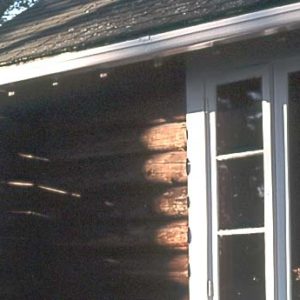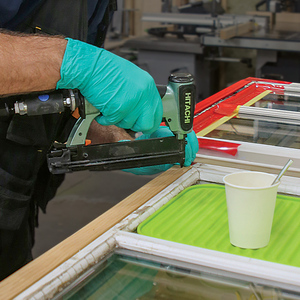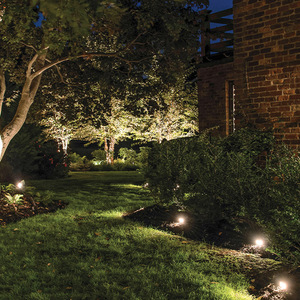(Pif, I know you’ve got the answer to this one)
Searched through the archive discussions of wood “eave troughs” (gutters), lots of great info. but didn’t find any specific discussion of how to fasten.
I’m facing a replacement on the north side of a rustic island cabin. Corner of foundation appears to have settled, bringing the closed (non draining) end of the gutter down a couple inches, and as a result standing water has caused major rot (place is basically a summer-cabin, hasn’t been well-maintained).
Replacement Doug Fir gutters have been ordered. Question is, what’s the best type of fastener to use and more importantly where should the fasteners be located?
Old gutters were nailed directly the the rafter tails, with 16d “toenailed” at angle through the bottom of the gutter into the end-grain of the rafter tails. Not sure this is the smartest method, but maybe it’s the best option.
Would like to use hot-dip galvanized screws on the replacement. Where’s the best place to locate them?
Also, what’s the best way to flash the butt joints (scarf would be better maybe)?
Am planning to bail the linseed oil to ’em before hanging.
Thanks,
Ed





















Replies
If you are ever over to the island, the wood gutters on the lighthouse museum are the first of my work you will see. About 28' long and I hung them alone.
To be honest with you, for a rustic cabin like that, I woulde probably just use the Plasmo vinyl gutter in brown colour. Wood gutter works great to flow into the classical style trim we have so common around here.
But since it is already ordered -
make sure that foundation isn't still moving around or the rot will replace itself.
definitely hit it with the oil first. Roll it upside down so it doesn't fill with leaves while it drys a day or two.
I use 3" screws in the back flange directly into the rafter tails. You should look for the stainless steel ones. Vikings has both the square drive and the GRK with Torx heads. I'm sure Rankins must have one or the other too.
Then you can spot bondo over the screw head or some good caulk. since the oil will still be uncured, you'll have to rough it off with a little sandpaper to get it to stick. I like geocel caulk.
For joints, such as a miter return at ends, I use PL Premium polyurethene construction adhesive.
For the lead drops, before hanging the gutter because it is easier to do all this over a bench than standing on a ladder - to seat them I drill the hole first and then tap the lead down into it, using a scrap of dowel to help shape it to the roll of the gutter bottom. After it fits fairly well, I trace it with a pencil and then take it out again. I use a small sharp chisle to flake out the seat for the lead flange so it is recessed and not himped up to hold water back.
Then I dry fit again and tap a little more. When I'm happy it will fit good, I remove it and run a bead of caulk to the bottom side of the flange and re-insert it, tapping it along the edges to fit smooth.
( I should have taken a series of photos last time i did this)
A couple of SS 3d fine will hold it in place while the adhesive caulk sets. Angle the nails so they don't protrude from the bottom.
After it is all up and in place right, give her another coat of oil.
Excellence is its own reward!
Thanks for the tips--very helpful. I'm a little bit hazy on the procedure for the lead drops, but I think I get the basic idea and will figure it out when I actually get started.
Well, I'll certainly have a good look at the museum gutters when I get out to Islesboro--ought to make time for that this fall. Sounds like "you're the man" out there for quality finish details. . .
The wood gutters were actually ordered by my wife's cousin (it's their grandparents' old place and now belongs to ten grandkids, most of whom rarely come). There was actually some tension over what kind of gutters to purchase (wood was deemed too expensive by some) and one of the cousins--sick of maintenance being postponed while decisions get endlessly discussed--just went and ordered them. I'm sort of stuck in the middle, but offered to hang them over the holiday when I'm out there.
It's a wonderful place but having ten owners (many of whom live out of state) makes it pretty challenging to get stuff done. You probably see that kind of thing on Islesboro all the time.
Incidentally, how often do you reapply the oil? Annually? And I assume you finish the whole thing--inside, outside, and end grain.
I usually just oil the inside and let the painters do the oil primer and paint to the exterior, but for a log cabin, oil throughour might be fien. Linseed encourages mildew blackening though.
I leave the annual maintainance to the caretakers. The better guys do it at least every other year. The others leave it until trees are growing in the debris and then call me again to replace...whatever needs replacing along with it, LOL
Keep it clean and oiled every year and it will outlast the cabin IMO.
I do see shared ownership. Usually where an inheritance stipulates sharing use and cost pro-rata. nobody ever agrees. That makes it hard for a contractor to make anybody happy. I remember one kitchen design conference with about five family branches represented. The loudest of the bunch was the new married in woman. Then after it was over, the wife of the guy with the checkbook called me aside to "explain things" and tell me to go ahead and ignore the desires of the newest in-law.
One of the bunch was an architect himself but he was wise enough to just nod and agree with my suggestions and not get himself in the line of fire. .
Excellence is its own reward!
Just to clarify--on the island there the traditional finishing method is to linseed oil the insides and paint the outsides of the gutters? That makes sense, because it would match the rest of the trim but the wood can still "breathe" through the linseed oil to dry out if necessary.
The reason I ask is there was some controversy in my wife's family about this issue. Being a new "in-law" when I first arrived, I wanted to make some serious contributions to the family's island property (since I'd be enjoying it, and it really was in dire need of some TLC). The trim hadn't been painted in probably twenty years, and having a little professional experience in that field I took it on one summer. Anyway, I carefully prepped, primed, and topcoated everything including the gutters (after replacing some rotted sections).
In any case, the problem gutter (the north side that now needs to be replaced) started peeling in a few places with a year or two because of the standing water (I raised the far end as far as I could but apparently it wasn't enough, especially over the winter when the pine needles and leaves would collect in there).
Some family members, seeing the peeling paint, proclaimed it a mistake to paint wooden gutters at all (although I pointed out that the root problem was the standing water rather than the paint). Just wondering what the tried and true traditional method is.
Maybe the safe thing for me to do, in terms of preserving family harmony, would be to linseed oil the whole shebang. As far as minimizing mildew, which as you say just loves to feed on linseed oil, I might use a linseed oil-based finish with a splash of mildewcide mixed in for the exterior finishing.
And as long as we're on this topic, I've been recommending that the family finish the dock with a linseed-oil based clear finish. The dock was rebuilt a couple years back (rough-sawn spruce or hemlock, I believe), and I think they'd get some more years out of it by finishing the wood. But one family member is concerned that the finish will make the dock slippery when wet (doubtful--a penetrating finish will soak into the rough-sawn wood and not leave a surface film).
What do you do on Islesboro?
Confirm - we do linseed the inside and paint the outside, generally with Ben Moore Oil Base Paint you can buy at Vikings, Rankins, or Schoenfelds
Given the state of family affairs and a proclivity for poor maintainance on this property, you might consider instead of using the oil, to paint the wood gutters with a penetrating epoxy mix to seal it. West system.
I have begun to consider this myself because of so many places where gutter cleaning is not high on anyones list and I expect it would last longer than the oil, as well as to fill the minor checks in the wood that collect dirt and promote rot. I have done this when repairing older ones out here and it seems to be holding a turn..
Excellence is its own reward!
Hmm--that epoxy's an interesting idea. Be a hell of a stinky mess, though (although moorwhite primer can get you a little lightheaded, too!).
Any opinion on the question of finishing docks?
BTW, not that it matters, but the only Ben Moore dealer in Camden is EBS (although I often buy from Viking and have it delivered).
AL makes a good dock finish
;).
Excellence is its own reward!
Check if the dock is hemlock or spruce. If it's spruce, I'd suggest teak oil instead of linseed. It cures faster, and it is not slippery when wet. (That's why ship decks were always made of teak--until the king of Thailand took that helicopter trip over what used to be his teak forests...and closed down teak exporting about 20 years ago.)
If it's hemlock, step back and leave it alone; hemlock's useful life in all kinds of wet conditions exceeds 20 years, whether sitting in the water, over the water, or buried in the ground. Among N. American woods, it's second only to cedar in rot resistance, and costs a good bit less....
Dinosaur
'Y-a-tu de la justice dans ce maudit monde?
That's interesting what you say about hemlock--although to be honest I'd like to see for myself a piece of hemlock buried underground for 20 years that hasn't pretty much disintegrated. Are you speaking from experience or basing that on some studies that were done? Just curious.
Are you speaking from experience or basing that on some studies that were done?
From experience and local knowledge both. There's a lot of hemlock around here; we call it pruche in French. All the local mills cut a run of it in late spring/early summer to get 6x6, 8x8, 10x10 and up. The offcuts are sold cheap as rough irregular planks. Ski centres that need extremely tough outdoor decks that don't have to be too elegant like those planks for that use. Also I build fixed docks in some of the smaller lakes, and where the client can't or won't pay for cedar posts, I use pruche. I've got some that are well past 12 years old with no sign of rot whatsoever. Finally I use hemlock 6x6's for building retaining walls for 'driveway boxes'--we're in the mountains, so everything either falls away from the road or falls down to it, especially lakefront lots. A lot of chalets need a built-up box level with the road to park the cars on. For this I admit I put a lot of effort into helping the hemlock fight the war as much as possible--tarpaper liner behind the wood, two coats of creosote on the 6x's before installing them, and so forth--but even walls built without benefit of these aids are surviving nicely after 13-15 years.
Dinosaur
'Y-a-tu de la justice dans ce maudit monde?
It will eventually rot though.
I have to change out a 9x9 x 40' sill beam that has only lasted two hundred years..
Excellence is its own reward!
Yeah, I think I'd call that 'eventually', LOL!!
Dinosaur
'Y-a-tu de la justice dans ce maudit monde?
Epoxy may not the best choice for coating the gutter trough, since it is not good at resisting UV. Soaking it into the end grain at the cuts and drops is a great idea, though. Those are the areas that fail first.
One restoration contractor near me installed an EPDM liner over (new) epoxy-soaked wood gutters. Expensive and time-consuming, but I bet they will last with little maintenance. I was thinking that some of these newer rubbery brush-on roof coatings might be another (similar but faster) solution. Annual oiling is just not realistic for most folks.
I have seen metal-lined wood gutters on older homes. Lead, copper, tin... Most of these look rough now, but may have lasted a long time.
Sometime gutters are attached to rafter tails on the sides, using angle brackets. The end grain does not hold well, and moisture can wick in around the fasteners.
I have had good results with PL Polyurethane Roof and Flashing sealant. More elastic than their other sealants. Black, but can be painted.
Surprised that no manufacturers (that I am aware of) have jumped in with a solid composite gutter. I don't mean flimsy pvc, I mean something solid and substantial with the traditional wood profiles. Wastes a lot of high-quality wood to make lengths of gutter, and it is not cheap. Wood is just not an ideal material for standing water, but the look is tough to beat.
Good point about the UV and epoxy.
Regarding the waste issue with wood gutters--sure, I imagine they're milling a pretty sizeable stick of timber to make those. And the same stick could have yielded a lot of 1x or 2x stock.
But the "waste" gets put to use in some fashion, doesn't it? I sure hope so--even if it just goes into composite materials like OSB.
I guess the issue, though, is the quality of the timber used to make gutters--I suppose it's pretty high-grade stuff, and has the potential to provide a lot of clear doug fir lumber.
You could probably say the same thing about buying quartersawn lumber--strictly from an efficiency standpoint, it's not the best way to saw a log because you waste more wood that flatsawn. But there are situations where you really need the quartersawn (or you'll just waste more wood down the road by replacing things).
Regarding waste:
Tends to be somewhat worse for gutters, since they are typically cut in very long lengths.
This is reflected in their cost.
I'm not saying they are environmentally unsound. Every material consumes resources, and not all are renewable.
Just seems it would be easier to 'cast' that shape, than to mill it from a solid piece.
My sense is that the technology exists to produce a composite equivalent that would outperform the wood. Should even be profitable with wood at $8 per foot, plus consideration of labor involved to give wood a fighting chance against mother nature.
I suppose the ubiquitous K-style gutter has taken over to the point that few care about an emulated wood equivalent. On many older homes, the wood gutters were a decorative element, so they just 'look wrong' without them.
"And as long as we're on this topic, I've been recommending that the family finish the dock with a linseed-oil based clear finish. The dock was rebuilt a couple years back (rough-sawn spruce or hemlock, I believe), and I think they'd get some more years out of it by finishing the wood."
A dock finish is much like a deck finish. The more pigments that you have it the longer it will last.
But you are right you don't want a film. Specially on a dock, because you will have lots of moisture working up from the bottom.
I would use any of the tinted or semi-transparent deck treatments.
BTW, leaving property jointly to a group of people is one of the worst things that people can do to their offspring.
Wait until some serious cash is need for maintance or one of the owners has serious money problems.
The will should state that the property is to be sold and proceeds divided. Of course on or more of the heirs can get togther and use there proceeds and other assests to buy it from the estate.